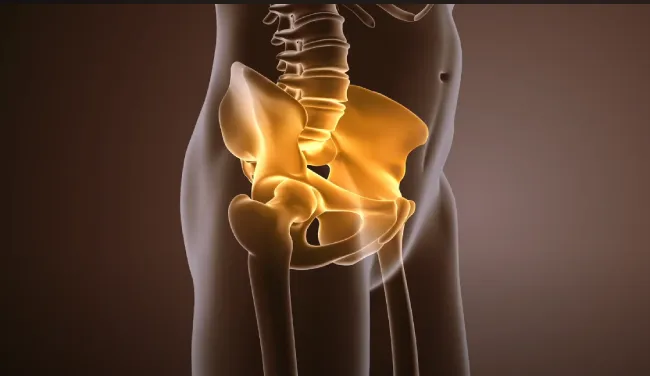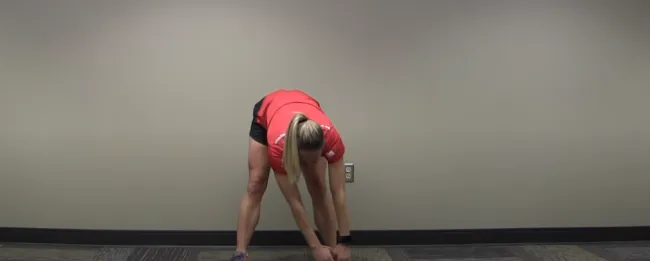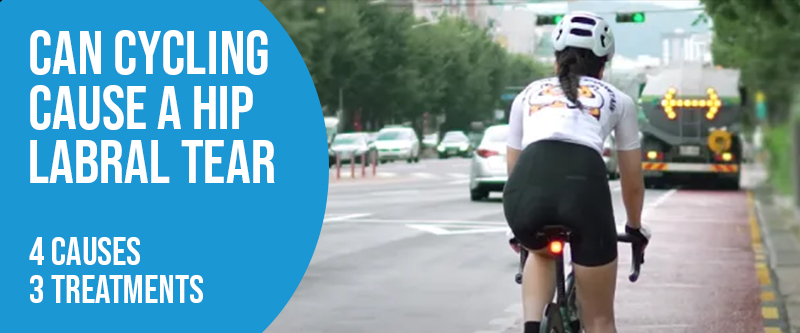Groin and hip pain, hip locking, or clicking sensations can be the symptoms of a hip labral tear. Nonsurgical and surgical methods, medications, and therapy can be the treatment methods for this problem.
Yes, cycling can be the reason for a labral tear in the hip. These usually occur during high-impact sports like rugby, football, or ice hockey or where you make repetitive movements, such as golf or cycling. But Labral tears are not always caused by a traumatic injury.
This blog post explores the causes, symptoms, diagnosis, and treatment of hip labral tears in cyclists to help you make informed decisions about your cycling habits and health.
Can Cycling Cause A Hip Labral Tear: 5 Risk Factors
Cycling has many benefits, such as strengthening muscles and improving circulation. It can also cause wear and tear, which can lead to injuries. Here are some specific causes:
Repetitive Motions and Overuse Injury
Cycling involves repetitive motions of the hips and legs, which can lead to overuse injuries. The hip joint is particularly vulnerable since it is one of the most mobile joints in the body. The labrum, a piece of cartilage that lines the socket of the hip joint, can become worn down and damaged with repeated friction and pressure.
Poor Bike And Fit Sitting Wrong
Another common cause of hip labral tear in cyclists is poor bike fit and wrong sitting position. An improperly fitted bike to a rider’s body puts excessive strain on their hips and legs, leading to injury. Maintaining the wrong sitting position can put pressure on the hip joint, causing damage to the labrum and surrounding tissues.
Intensity change
Abrupt changes in intensity can also lead to hip labral tears in cyclists. Sudden accelerations, climbs, and descents can put a lot of stress on the hips and legs, causing injury if the body is not prepared for these movements. Cyclists should always warm up properly and gradually increase the intensity of their rides to avoid damage.
Riding Surfaces And Bikes
The type of bike and riding surface can also play a role in hip labral tear injuries. Mountain bikers, for example, are more susceptible to this type of injury because of the challenging terrain and technical descents they encounter. Road cyclists who frequently ride on uneven or bumpy surfaces can also be at risk for hip labral tear due to increased strain on the hip joint.
Cycling And Hip Labral Tear: 4 Symptoms

Identifying the symptoms of this injury is crucial for early diagnosis and prompt treatment. Here are some symptoms cyclists may experience:
Groin And Hip Pain
Groin and hip joint discomfort are among the most common symptoms of hip labral tear. This can occur during or after cycling and may develop gradually. Some key points to note include:
- There is pain in the groin area or the front of the hip joint.
- Pain that may radiate to the back of the hip joint and buttocks.
- Pain that may be dull or sharp and may worsen with movement.
Stiffness And Limited Range Of Motion
Hip labral tears may also cause a limited range of motion and stiffness, affecting cyclist’s ability to perform at their best. Some important points to consider:
- Stiffness and reduced flexibility around the hip joint.
- Difficulty in moving the hip joint through its full range of motion.
- A sensation of tightness or pulling in the hip joint.
Hip Locking Or Clicking Sensations
Another possible indication is clicking or locking sensations in the hip joint during or after cycling. Some valuable points to keep in mind include:
- During hip movement, there may be a clicking sensation.
- A locking sensation may occur when the hip joint gets stuck or catches.
- There is a feeling of instability in the hip joint.
Difficulty in Regular Movement
Hip labral tears can also make it difficult for cyclists to walk, stand, or sit comfortably. Here are some important things to note:
- Difficulty in bearing weight on the affected hip.
- Pain or discomfort when sitting for prolonged periods.
- Difficulty in standing up from a sitting position.
3 Diagnoses Ways For Hip Labral Tear Caused By Cycling

A hip labral tear can be painful for cyclists who may be experiencing groin pain, clicking or locking sensation while pedaling, decreased range of motion, or hip stiffness. Proper diagnosis is necessary for prompt treatment and to prevent further damage. Here are some of the ways to diagnose hip labral tears in cyclists:
Physical Examination
The doctor will check your hip joint for tenderness around the hip joint, limited range of motion, and any abnormal clicking or popping sensations. They will also review your medical history, including previous injuries, surgeries, or chronic conditions such as osteoarthritis or hip dysplasia.
Imaging Tests: X-Rays, MRI, CT Scan
Imaging tests on the hip joint can be performed to detect any abnormalities. X-rays evaluate bone structure, while MRI and CT scans can show soft tissue damage such as labral tears. These imaging tests can also reveal any bone abnormalities, such as bone spurs or fractures, that may contribute to hip pain.
Arthroscopic
During an arthroscopic evaluation, surgical instruments and a small camera are inserted into the hip joint for a closer look if the diagnosis is still unclear. A diagnostic injection, a combination of a local anesthetic and steroids injected into the hip joint, is another diagnostic tool that your doctor can use to simultaneously diagnose and treat any labral tears or other conditions. If the injection provides temporary relief of hip pain, it may be a sign that a labral tear or other disease is present.
Hip Labral Tear Exercises for Hip Health
The proper hip strengthening exercises can prevent injuries like hip labral tears. This guide delves into a series of exercises designed to target key hip muscles, enhance stability, and promote overall hip well-being. Let’s explore these hip labral tear exercises to empower you to have more muscular, healthier hips.
- Standing Hip Abduction: Stand upright and lift one leg sideways while keeping the other straight. Repeat on both sides.
- Single Leg Bridge: Lie on your back with your knees bent. Lift your hips off the ground using one leg. Lower and repeat on the other side.
- Partial Squats: Stand with feet shoulder-width apart. Maintain a straight posture while bending your knees slightly. Return to the starting position.
- Clam Shell: Face your side with your knees bent. Keep your feet touching. Lift the top knee while keeping your feet together, lower, and repeat.
- Side-Lying Leg Lift: Keep your legs straight. Lift the top leg upward, then lower it. Switch sides and repeat.
Exercises to Avoid with a Torn Hip Labrum
Knowing which exercises to avoid is essential when dealing with a torn hip labrum. Here are some exercises that individuals with a torn hip labrum should avoid:
- Deep Squats: Performing deep squats can strain the hip joint excessively. Aggravating a torn labrum.
- High-Impact Activities: Running, jumping, or intense aerobics can jar the hip joint and, worse, labral tears.
- Leg Press Machines: Using leg press machines with heavy weights may strain the hip joint and increase discomfort.
- Hip Flexor Stretches: Overstretching the hip flexors can cause additional strain on the hip labrum and hinder healing.
- Leg Raises: Straight leg raises can engage the hip flexors and potentially exacerbate symptoms of a torn labrum.
Not to Do When Dealing with a Hip Labral Tear
When facing a hip labral tear, you must know activities and behaviors that could worsen your condition. Here are some key things to avoid when managing a hip labral tear:
- Ignoring Symptoms: Disregarding pain, discomfort, or hip movement limitations can exacerbate a labral tear. Listening to your body and seeking medical attention is essential if you experience persistent symptoms.
- Overdoing High-Impact Exercises: High-impact exercises like running, jumping, or heavy lifting can strain the hip joint and aggravate a hip labral tear. Opt for low-impact activities that are gentler on the hip joint.
- Neglecting Rehabilitation: Skipping or neglecting recommended rehabilitation exercises and physical therapy can slow down the healing process and impede recovery from a hip labral tear.
- Poor Posture and Body Mechanics: Maintaining improper posture or body mechanics during daily activities or exercise can place undue stress on the hip joint, potentially worsening a hip labral tear. Focus on maintaining good posture and body alignment.
- Neglecting Rest and Recovery: Failing to allow your hip joint adequate rest and recovery time can hinder healing and prolong the recovery process for a hip labral tear. Listen to your body’s signals and prioritize rest when needed.
Cycling Related Hip Labral Tears: 3 Treatments
A hip can cause significant pain and discomfort, preventing you from performing everyday tasks. Fortunately, both non-surgical and surgical options are available to treat this condition.
Non Surgical
- Rest: Healing requires rest. A patient with a hip labral tear should avoid any activity that causes pain or aggravates the injury.
- Ice: Applying an ice pack to the affected area for 15 to 20 minutes a few times daily can help reduce pain and inflammation.
- Physical Therapy: This is an essential component of treatment for hip labral tear. It can help strengthen the hip muscles and improve flexibility, reducing the possibility of re-injury. Reducing re-injury risk can be achieved by improving flexibility and strengthening muscles around the hip.
- Medication: You can manage pain with over-the-counter pain relievers. Always consult with a doctor before taking any medicine.
Surgical
Treatments for hip labral tears, such as rest and physical therapy, may not always provide enough relief. Surgery is often a necessary option. Some surgical options may be available in treating hip labral tears in cyclists.
- Labral Repair: In severe cases of hip labral tear, the labrum may require repair through surgery. A surgeon may use stitches or anchors to reattach the hip socket to the torn labrum.
- Labral Debridement: Sometimes, a surgeon may remove the torn part of the labrum, called debridement, while preserving the healthy tissue. This procedure is less invasive than labral repair.
- Hip Arthroscopy: Hip arthroscopy is another less invasive surgery option that can be used to treat hip labral tears. It involves using a small camera and surgical instruments inserted into the hip joint through small incisions.
Rehabilitation

After hip labral tear treatment, a rehabilitation program is necessary for full recovery. Physical therapy can help with stretching and strength exercises, aiding muscle growth and mobility. Cyclists can keep hip labral tears at bay by:
- Proper Warmup and Stretching: Warming up before cycling and performing stretches to increase the flexibility of the hip muscles reduce the risk of hip labral tear.
- Proper Equipment: Cyclists must ensure they have the right equipment for cycling, such as properly fitting bikes and shoes.
- Adjust Cycling Practices: Cyclists should also consider adjusting their cycling practices, such as limiting the duration of cycling or avoiding rough terrain, to avoid unnecessary strain on the hip joint.
- Physical therapy: After surgery, it is necessary to engage in rehabilitation to regain flexibility, strength, and mobility in the hip joint.
Conclusion
Cycling can cause a rupture of the labrum in the hip, but it’s not all doom and gloom for cyclists. By understanding what causes this injury and being proactive in preventing it, riders can continue to enjoy this exhilarating sport without suffering from the pain.
It’s essential to pay attention to bike fit and riding position and to avoid abrupt changes in intensity that can lead to overuse injury. If you experience problems, diagnosis and treatment for hip labral tears are available. Physical examinations and imaging tests can assist in proper diagnosis, and various treatment options are available.
Non-surgical options such as rest, ice, physical therapy, and medication can help, while more severe cases may require surgical intervention. It’s also important to focus on rehabilitation and preventive measures to avoid future injuries.
FAQs
What Aggravates Hip Labral Tear?
Hip labral tears rarely cause any symptoms. People who stand, sit, walk, or run for extended periods may experience hip or groin pain, especially if they stand, sit, or walk for long periods.
Is Cycling Good For Hip Labral Tear?
Exercise and movement are beneficial in treating hip labral tears. You should continue to do whatever you can tolerate. Labral tears are often treated with biking.


